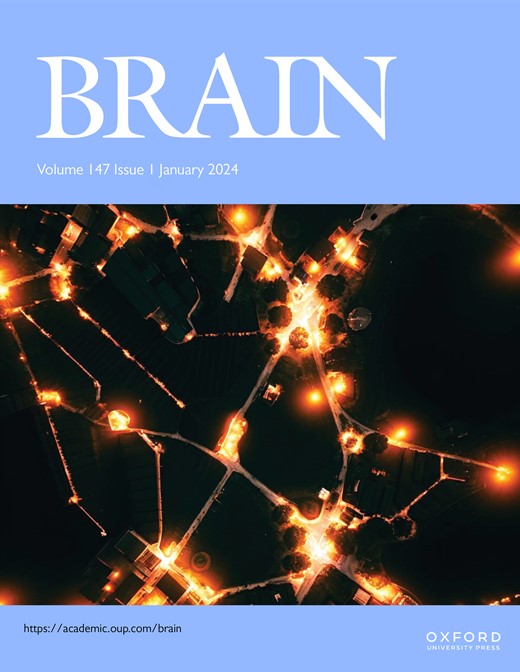Targeting lipid droplets in FUS-linked amyotrophic lateral sclerosis mitigates neuronal and astrocytic lipotoxicity
IF 11.7
1区 医学
Q1 CLINICAL NEUROLOGY
引用次数: 0
Abstract
Amyotrophic lateral sclerosis (ALS) is a fatal neurodegenerative disorder characterized by the progressive loss of motor neurons, muscle atrophy, and systemic energy imbalance. Increasing evidence suggests a metabolic shift in ALS from glucose metabolism toward fatty acid utilization; however, the downstream consequences of this reprogramming on disease progression and neuropathology remain poorly defined. We investigated neurometabolic changes in ALS using in vitro and in vivo models of familial ALS expressing the human fused in sarcoma variant R521G (hFUSR521G), along with post-mortem spinal cord tissue from ALS-FUS cases. A combination of unbiased quantitative metabolomic profiling, immunolabeling, and biochemical and molecular approaches were employed. Mass spectrometry of cortical tissue from hFUSR521G mice and littermates revealed a significant increase in acylcarnitine moieties, key substrates used in mitochondrial β-oxidation and cellular energy production. Complementary cytohistological analyses in hFUSR521G mice demonstrated increased lipid droplets (LDs) and peroxidized lipids in both neurons and astrocytes, consistent with our post-mortem findings in spinal cords of individuals carrying FUS R495X or K510E mutations. Arimoclomol, previously shown to ameliorate behavioral phenotypes in this ALS mouse model, was found to enhance lipid metabolism and reduce lipotoxicity in hFUSR521G mice and in cultured neurons and astrocytes expressing FUS R521G. Mechanistically, arimoclomol enhanced LD-mitochondrial contacts and stimulated mitochondrial β-oxidation-dependent lipid catabolism under both basal and pro-inflammatory conditions. This effect was abrogated by etomoxir, an irreversible inhibitor of CPT1, the rate-limiting enzyme of the carnitine shuttle, highlighting a CPT1-dependent mechanism for lipid mobilization. Together, these findings reveal a previously unrecognized role for mitochondrial lipid metabolism in ALS pathogenesis and identify a therapeutic pathway for mitigating the cytotoxic consequences of lipid and acylcarnitine accumulation in FUS-associated ALS.靶向脂滴在fus连锁肌萎缩性侧索硬化症减轻神经元和星形细胞脂毒性
肌萎缩性侧索硬化症(ALS)是一种致命的神经退行性疾病,以运动神经元的进行性丧失、肌肉萎缩和全身能量失衡为特征。越来越多的证据表明,ALS的代谢从葡萄糖代谢转向脂肪酸利用;然而,这种重编程对疾病进展和神经病理学的下游后果仍然不清楚。我们利用表达人融合肉瘤变体R521G (hFUSR521G)的家族性ALS体外和体内模型,以及ALS- fus病例的死后脊髓组织,研究了ALS患者的神经代谢变化。结合无偏定量代谢组学分析,免疫标记,生化和分子方法被采用。hFUSR521G小鼠和窝鼠皮质组织的质谱分析显示,酰基肉碱部分显著增加,这是线粒体β-氧化和细胞能量产生的关键底物。hFUSR521G小鼠的补充细胞组织学分析显示,神经元和星形胶质细胞中的脂滴(ld)和过氧化脂质增加,这与我们在携带FUS R495X或K510E突变的个体脊髓中的死后发现一致。在hFUSR521G小鼠和培养的表达FUSR521G的神经元和星形胶质细胞中,先前被证明可以改善ALS小鼠模型的行为表型的阿利莫洛尔被发现可以增强脂质代谢并降低脂毒性。在机制上,在基础和促炎条件下,阿利莫洛尔增强ld -线粒体接触并刺激线粒体β-氧化依赖的脂质分解代谢。这一作用被依托莫西(一种不可逆的CPT1抑制剂)所消除,CPT1是肉碱穿梭的限速酶,强调了CPT1依赖于脂质动员的机制。总之,这些发现揭示了线粒体脂质代谢在ALS发病机制中以前未被认识到的作用,并确定了减轻fus相关ALS中脂质和酰基肉碱积累的细胞毒性后果的治疗途径。
本文章由计算机程序翻译,如有差异,请以英文原文为准。
求助全文
约1分钟内获得全文
求助全文
来源期刊

Brain
医学-临床神经学
CiteScore
20.30
自引率
4.10%
发文量
458
审稿时长
3-6 weeks
期刊介绍:
Brain, a journal focused on clinical neurology and translational neuroscience, has been publishing landmark papers since 1878. The journal aims to expand its scope by including studies that shed light on disease mechanisms and conducting innovative clinical trials for brain disorders. With a wide range of topics covered, the Editorial Board represents the international readership and diverse coverage of the journal. Accepted articles are promptly posted online, typically within a few weeks of acceptance. As of 2022, Brain holds an impressive impact factor of 14.5, according to the Journal Citation Reports.
 求助内容:
求助内容: 应助结果提醒方式:
应助结果提醒方式:


